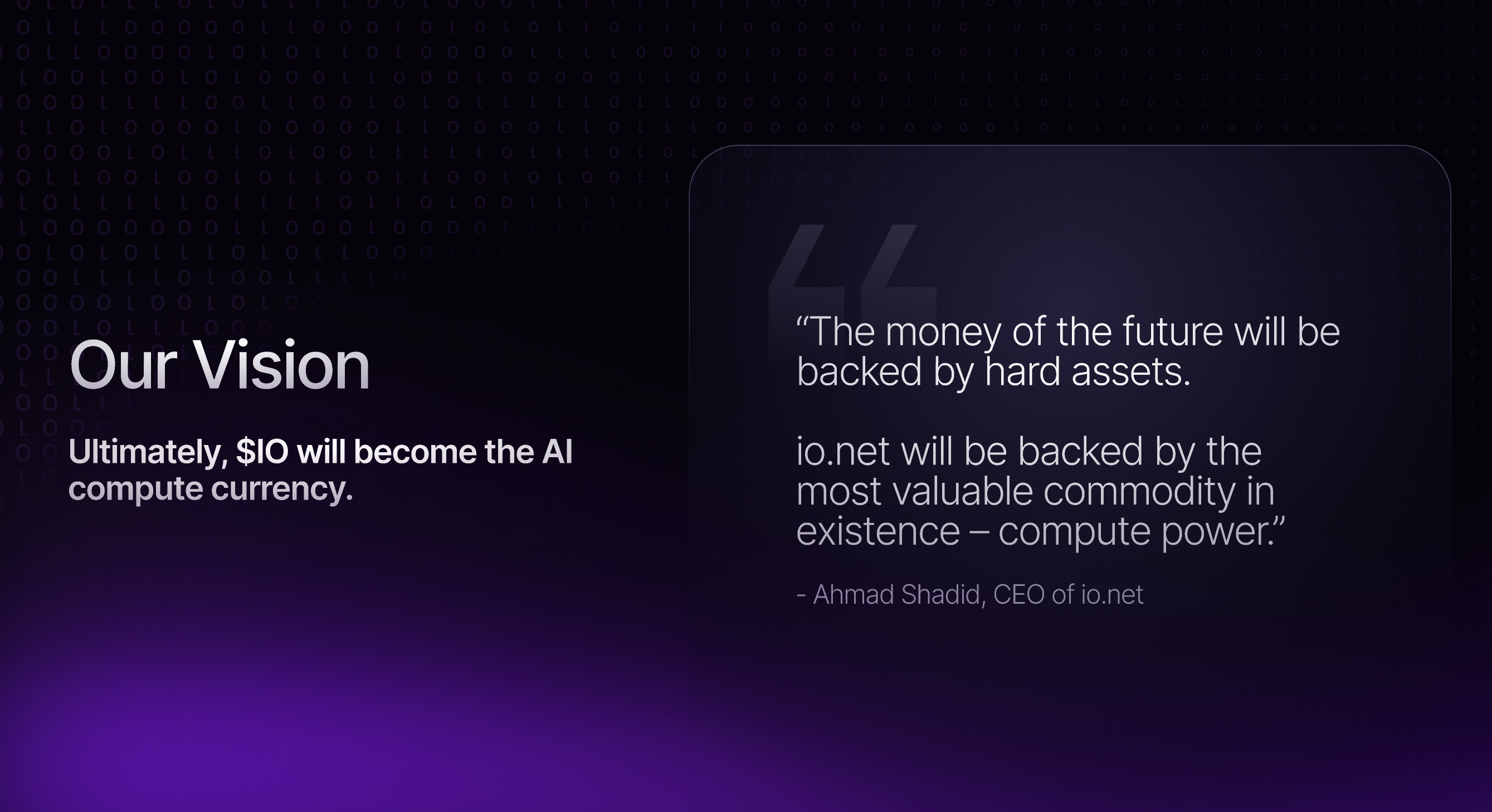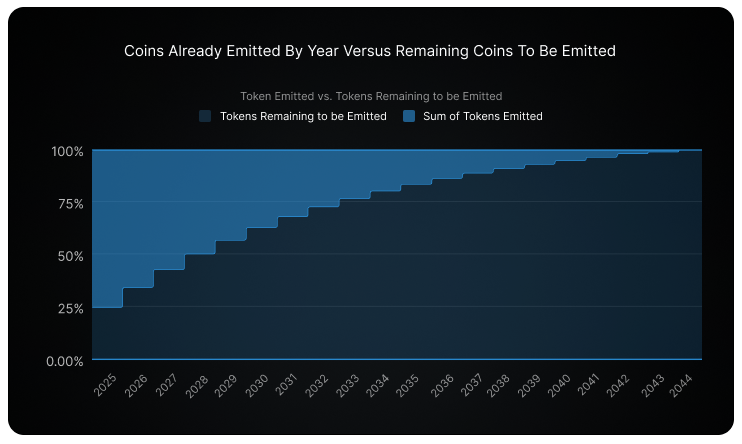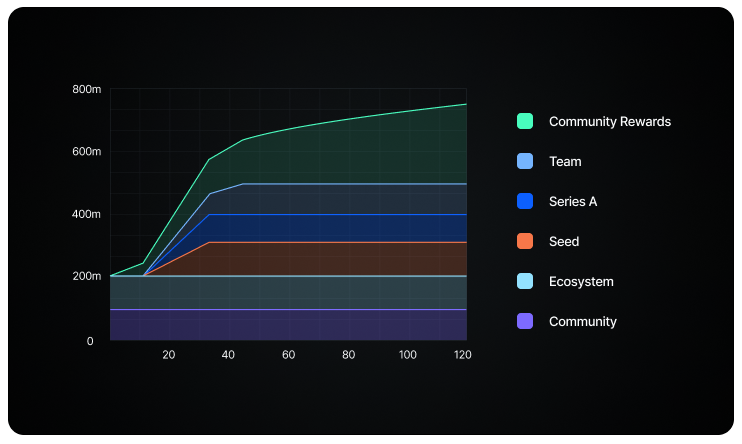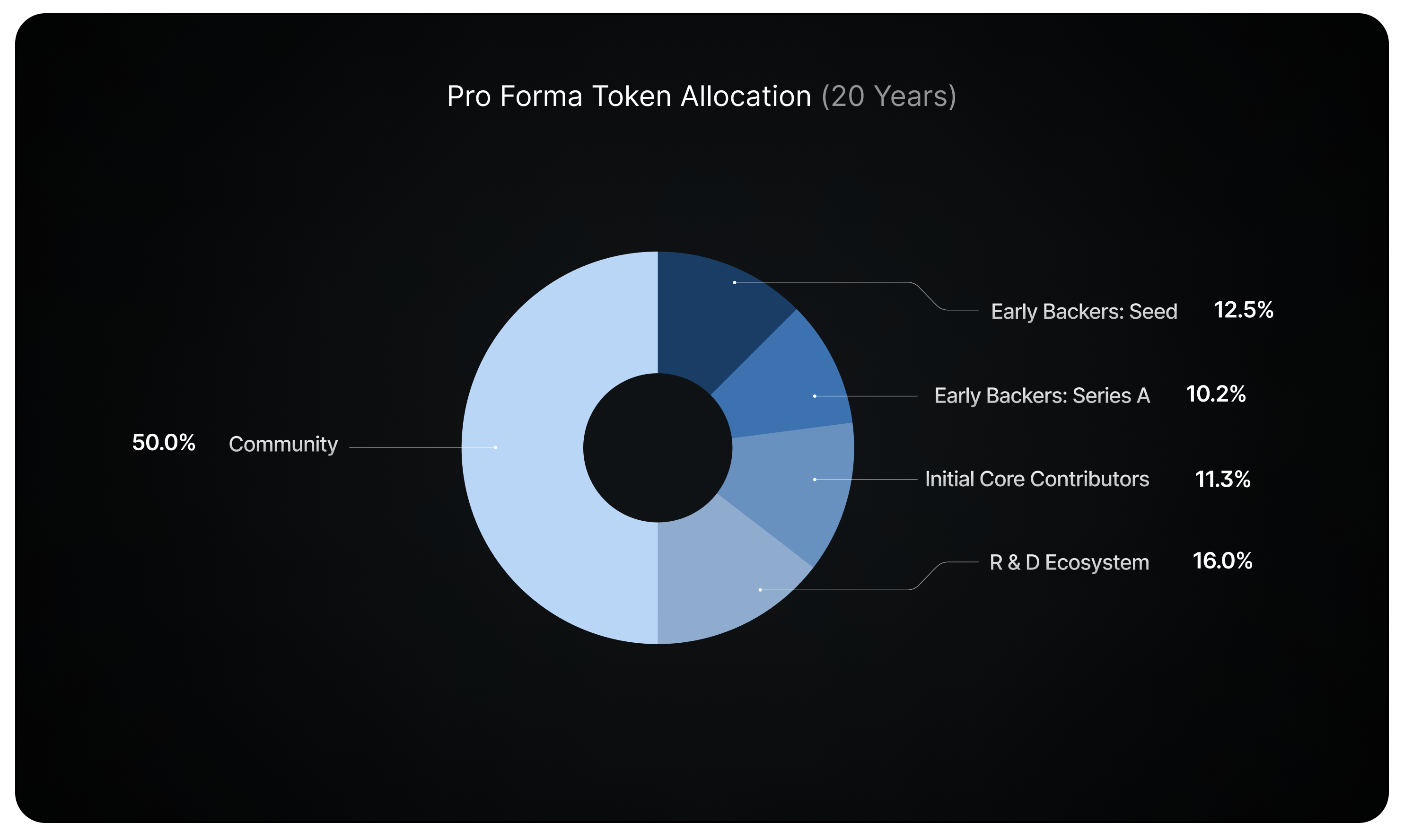IO Coin
The Currency of Compute

Tokenomics below are under construction and subject to revision prior to launch.
The Currency of AI
Introducing io.net
io.net was created with the vision of creating a globally accessible, decentralized cloud computing network with the goal of providing affordable, flexible, and permissionless access to compute capacity for builders everywhere. We believe that compute is the most important resource of our generation - it is this generation’s “digital oil”, powering a technological industrial revolution.
If compute is “digital oil”, it needs a petro-dollar to be a transaction and settlement standard for the commodity that powers the most innovative industries of today from artificial intelligence to autonomous vehicles.
io.net is creating that standard, $IO, to be the currency of compute, powering an ecosystem of products and services that enable access to compute as a resource and as an asset.
We're establishing an ecosystem built on top of compute as a currency. This ecosystem provides a suite of tools and services for building, training, and deploying machine learning models - all on chain, powered by Aptos and Solana.
This enables users to deploy their models for real-time inference, with features like batch inference and efficient training and fine-tuning of machine learning models. To put it simply, $IO represents the currency of computing power. Just as the US Dollar is the standard for oil transactions, $IO unlocks computing resources on a global scale.
$IO seeks to become the universal compute exchange medium for users and enterprises worldwide.
Today compute is a scarce resource relative to the growth in demand. Driven by extraordinary growth in industries like artificial intelligence and machine learning, the demand for compute has created enormous value accrual for traditional cloud providers and GPU companies but has also created limited access for startups, independent builders, and innovators in developing markets.
To solve this, io.net is building IOG Network, a decentralized “Internet of GPUs” that will be powered by millions of distributed nodes operated by everyone from consumers to crypto miners to independent enterprise grade data centers. This network will become progressively decentralized and fully governed by the users and operators in the network while enabling democratized, permissionless access to on-demand AI compute for builders around the globe.
The IO ecosystem today is comprised of these core elements :
io.net - Development company that maintains the IOG Network and builds products and services on top of the network, such as IO Cloud, IO Worker, IO Models, and IO ID.
IOG Network - Also referred to as the Internet of GPUs, or “IOG”, IOG Network is a decentralized physical infrastructure network of independently operated, geo-distributed hardware nodes that provide permissionless access to on demand compute.
IOG Framework - Open source, developer friendly SDK that enables builders to deploy products and services on top of the Internet of GPUs.
IO Cloud - Cloud platform that allows developers to virtualize infinitely scalable and configurable clusters on demand using the compute capacity in the IOG Network.
IO ID - Universal identity management for the IO Ecosystem
What is IO?
IO is the native Coin of the IOG Network.
IO Coins facilitate economic incentives within the network, balancing the needs of three main groups within our ecosystem:
- GPU Renters (also referred to as Users ) such as Machine Learning Engineers who are seeking to purchase GPU computing power on the IOG Network. These engineers can use $IO to deploy GPU clusters, Cloud gaming instances, and build Unreal Engine 5 (and similar) pixel streaming applications. Users can also include individual consumers who are looking to conduct serverless model inferences on BC8.ai an hundreds of apps and models that io.net will host in the future.
- GPU Owners (also referred to as Suppliers) such as independent data centers, crypto mining farms, and professional miners, that are seeking to supply their underutilized GPU computing power on the IOG Network.
- IO Coin Holders (also referred to as Community ) who participate in providing crypto economic security and incentives to align mutual benefits and penalties between all parties in the interest of network growth and adoption.
It's important to note that these groups are not mutually exclusive, as an $IO Coin Holder can also be a GPU Renter or GPU Owner, or both.
IO is an SPL token that is built on the Solana blockchain. As of 4/16/24, $IO has not yet launched.
IO Contract Address: N/A
Universal Payment
Payments in the IO Ecosystem are always made in $IO behind the scenes, but we are flexible in allowing Users deploying clusters or using any other service to pay in Fiat, USDC or any other supported network tokens. We abstract friction away in the payment system while creating structural demand for $IO in the payments mechanism.
Suppliers providing their compute also have the option to receive payments in native $IO, enabling automatic conversion to USDC.
In order to incentivize payment in $IO, io.net charges transaction fees to both the User and the Supplier when the network facilitates a compute reservation, but does not charge transaction fees on Rewards.
User Fees
- Payments made in USDC are subject to 2% facilitation fee
- Payments made in $IO incur no fees.
Suppliers Fees
- Emission rewards incur no fees
- Hire/Compute job earnings
- Payments to supplier 100% in USDC incurs a 2% fee.
- Payments to suppliers in $IO incur no fees.
Network Security & Collateralization
$IO is critical to ensure the fidelity of the network and incentivize the overall health of the network. There are two primary ways the $IO coin is used to secure the network.
First, there is a minimum amount of $IO collateral that must be staked in order for a node to receive $IO Idle Rewards from the network..
Second, $IO Coin Holders can stake additional $IO collateral, up to the maximum stake per node, in order to earn $IO Rewards in return for securing the fidelity of the network.
These mechanisms are discussed in more detail in the Earning $IO and Staking sections.
IO Tokenomics
io.net’s tokenomics are based on three principles:
- A fixed maximum supply of 800 million $IO
- Hourly rewards to Suppliers and their Stakers
- An $IO burn mechanism
Fixed Supply
There is a fixed maximum supply of 800 million $IO coins.
500 million $IO coins will be distributed at launch, and the remaining 300 million will be emitted and paid to Suppliers and their Stakers as Rewards each hour.
Hourly Rewards
Rewards will be released to Suppliers and their Stakers hourly over 20 years. Rewards follow a disinflationary model, starting at 8% in the first year and decreasing by 1.02% per month (~12% per year) until reaching the cap of 800 million $IO.
More details on the emission and annual inflation rates can be found in the diagrams below.

Figure 1. Emission rate as a function of total emissions pool

Figure 2. Yearly Inflation Rate

Figure 3. Coins already emitted by year versus remaining Coins to be emitted
Burn Mechanism
$IO uses a programmatic coin burn system where revenues generated by io.net from the IOG Network are used to purchase and burn $IO. The $IO burn mechanism adjusts the amount of $IO to be burned based on $IO’s price.
This reduces the outstanding supply of Coins and creates deflationary pressure on $IO.
io.net generates revenue by charging fees to both Users and Suppliers. io.net charges Reservation Fees when a reservation for computational power is made, and charges Payment Fees depending on how the User chooses to pay for the reservation and how the Supplier chooses to withdraw Hire Fee earnings.
GPU Renter Fees
Reservation Fees
- The IOG Network charges users a 0.25% reservation fee on the total cost to reserve the compute. This is added to the Renter’s cost when reserving.
Payment Fees
- For 100% USDC payments, they are charged 2%.
- For 100% $IO payments, there are no fees.
GPU Supplier Fees
Reservation Fees
- The IOG Network charges users a 0.25% fee on the total cost to reserve their nodes. This is charged to the Supplier when they are paid for the compute.
Payment Fee
- For 100% USDC payments, they are charged 2%.
- For 100% $IO payments, there are no fees.
Allocation
Initial Allocation
io.net will have an initial supply of 500,000,000 $IO at genesis, split across five categories: Seed Investors, Series A Investors, Core Contributors, R&D and Ecosystem and Community.
This supply will grow to 800,000,000 IO over 20 years as $IO is emitted to incentivize network growth and adoption.
Unlocks and Rewards
The initial 500 million supply will be subject to the schedules detailed in the sections below. In addition, the circulating supply will increase as rewards are issued. Rewards are unlocked upon receipt and will add to the circulating supply.
Circulating Supply is defined as the amount of $IO in general circulation without on-chain transfer restrictions.
Locked Supply is defined as the amount of $IO that is unvested and not yet circulating.
Available Supply is defined as the amount of $IO Coins that are either part of the circulating supply or have been issued but remain locked. Rewards that have not yet been issued are not included in the available supply.
Max Supply is the maximum amount of $IO Coins that will exist after all tokens have been emitted.
More detail is shown in the chart below:

Pro Forma Allocation
As the IOG Network emits Rewards, the share of early backers and Core Contributors will continue to decrease. As such, the Community’s share will grow to ~50% after the distribution of all rewards.


Coin Restrictions
Investors
io.net has raised equity funding from some of the most prominent Venture Capital ("VC") firms in the world including Hack VC, Multicoin Capital, 6th Man Ventures, M13, Delphi Digital, Solana Labs, Aptos Labs, OKX Ventures, Foresight Ventures, Longhash, SevenX, ArkStream, Animoca Brands, Continue Capital, MH Ventures, Sandbox Games, and Sandbox as well as prominent industry leaders including Solana founder Anatoly Yakovenk, Aptos founders Mo Shaikh and Avery Ching, Yat Siu of Animoca Brands and Sebatstien Borget of Sandbox Games.
IO allocated to investors are restricted for a three-year period, with transfer restrictions released from $IO in 24 equal tranches at the end of the 13th month until the end of the 36th month anniversary of the Initial Distribution Date.
Employees
Visit the io.net Inc. LinkedIn page to learn more about the team building the technical and operational systems required to contribute to and maintain IOG Network. Most employees of io.net have chosen to add the company to their LinkedIn profile.
io.net Inc. does not control who adds the company to their LinkedIn profile
$IO allocated to employees of io.net Inc. are restricted for a four-year period, with transfer restrictions released from $IO in 36 equal tranches at the end of the 13th month until the end of the 48th month anniversary of the Initial Distribution Date
Earning $IO
There are three ways to earn $IO on io.net - by supplying hardware to the network and maintaining availability to earn an hourly Availability Reward, by being hired by a User and earning an hourly Hire Fee (also referred to as Hire Rate), or by staking $IO as collateral to nodes in the network and earning an hourly Staking Reward. Each of these mechanisms are described in more detail below.
Availability Rewards
Availability Rewards are paid to Suppliers on an hourly basis for making their GPU or CPU available on IOG Network and incentivizing supply side network growth. This fee is valued in USD and denominated in $IO.
The hourly Availability Rewards are calculated on a per node basis, and consider a number of factors such as Bandwidth (Connection Speed), Uptime Ratio, Hardware Type, etc. The formula for Availability Reward is based on a benchmark model that allows the Supplier to achieve an approximate 1.5 year payback on their hardware CapEx assuming the node is only earning Availability Rewards
As such, Suppliers can model their Availability Rewards using the formula below:
Approximate Per Node Hourly Availability Rewards = Staker Collateral Multiplier x (Hardware CapEx / Hours in 18 Months) Uptime Percentage x 95% Supplier Share
Note: This is not the internal formula used for Maintenance Fees. Higher tier hardware (e.g. H100s and A100s) have a shorter than 1.5 year payback while lower tier cards have a longer payback period. Higher Bandwidth is also rewarded more than lower connection speeds. The benchmark is based on a median 1.5 year payback and the formula above is provided for modeling purposes only.
Supplier Share is set to 95% as Stakers earn a 5% portion of a Supplier’s Availability Rewards
Staker Collateral Multiplier references an increase in Availability Rewards as the collateral staked increases.
For each node, the Maintenance Fee is paid when the device is committed and not yet hired by any workload.
In order to ensure that nodes are incentivized to provide value to the network, and to secure network fidelity, Availability Reward can be slashed. Availability Reward slashing occurs when a node achieves less than 100% uptime during a given hourly epoch. If this occurs, the Availability Reward for that hourly epoch is slashed.
In order for a node to earn the Availability Reward, each node has to stake the minimum 100 $IO. Staking additional $IO per node beyond the minimum collateral required increases hourly $IO rewards beyond the benchmark 1.5 year payback. Each node will have a maximum stake determined by the Hardware Model, Bandwidth (Connection Speed), Uptime Ratio, and Job Hours Done.
Rewards update every hour in the “Earnings & Rewards” tab for $IO Worker, and Suppliers can claim accrued $IO rewards at any time.
If the node goes offline while it is available, the node’s stake is slashed for the value of one hour’s Availability Reward in addition to losing the Availability Reward it would have received in that hour. If a node is terminated or paused, that node will only lose the Availability Reward it would have earned in that hour.
To prevent nodes from constantly connecting and disconnecting, there is a 12 hour cooldown period on Availability Reward earnings whenever a node is terminated or paused and then subsequently reconnected.
Hire Fee
The Hire Fee is earned by Suppliers when their hardware is hired by Users, and is calculated as the sum of each node’s individual hourly Hire Rate multiplied by the computation hours reserved. The Hire Fee is denominated in USD, and io.net maintains the model that determines the hourly Hire Rate for each node. The Hire Rate is the baseline cost to reserve these nodes for computational workload, and additional hire fees may apply when a Supplier provides the network with additional optional computational capacities (discussed further below).
Total Hire Rate=Current # of Cards on the Worker x Current Card Price x Computation Hour Reserved x (1 + SUM of Modifier Options) x 99% Supplier Share
Supplier Share of the Hire Fee is 99% since 1% is shared with Stakers.
Modifier Options are items that io.net recognizes as additional services and hardware the supplier has put in place to increase the performance of the overall cluster.
Current list of modifiers:
- Bandwidth
- Low speed +0%
- Mid speed + 1%
- High speed + 2.5%
- Location
- Normal +0%
- Premium +2.5%
- GPU Interlink Options
- NVLINK +2%
- Node Disk Attributes
- Capacity 500Gb Standard +0%
- Capacity 1TB to 5TB +2%
- Capacity 10TB+ > Varies
- Standard SSD +0%
- NVME High Speed Interconnect +5%
In order to earn the entire Hire Fee, the Supplier must provide the entirety of the reserved computational capacity for the duration that it was reserved for. If the Supplier does not provide the full reserved computational capacity, the Supplier’s Hire Fee will be reduced based on the amount of hourly capacity that was not provided.
Staking Rewards
Staking $IO as collateral is critical to ensure the fidelity of the network and incentivize the overall health of the ecosystem. Any IO Coin Holder, whether they are a User, Supplier, Community member, or other, can participate in $IO Staking.
To stake $IO as Collateral, a Staker simply chooses a Node Operator in the network, an amount of $IO to stake, and stakes the $IO to the Node Operator. Once $IO is staked to the Node Operator, the Staker earns a share of the hourly Staking Rewards that are paid by the network to the Node Operator. Stakers can stake to as many Node Operators in the network as they choose, and their hourly rewards are the sum of the Staker’s share of each Node Operator’s hourly rewards.
Stakers share 5% of their $IO Rewards with Suppliers.
Staking Summary
In order to earn Availability Rewards for making hardware available on the network, nodes need to achieve a minimum of 100 $IO collateral per node. This collateralization ensures that Suppliers are committed to the network and prevents spamming the network with low quality hardware to farm Availability Rewards. The minimum collateral per node can be provided by the Supplier or any other Staker. Additional $IO beyond the minimum collateral can be staked per node to earn a greater share of total Staking Rewards.
Once staked, it takes 7 days for $IO collateral to be unstaked. $IO collateral cannot be unstaked while a node is hired. The collateral acts as an insurance fund. If a data leak, spoofing or other malicious activities are detected by io.net, the $IO collateral and any accrued earnings or rewards will be slashed to compensate for data leak and other damage to the consumer
The collateral staked per node acts as a form of priority queue to be hired. io.net rewards premium and high earning jobs to Suppliers that are committed to the network and achieve a greater stake per node.
The maximum stake per node is determined by the hardware, connection speed, and other Modifier Options pursuant to the formula below. Since Maintenance Fees paid increase if more $IO collateral is staked, io.net rewards the most valuable nodes by allowing them to earn more by adding more collateral.
Per Node Max Stake = Device Max Stake x (2 + 3 x [SUM of Modifier Options])
Device Max Stake Multiplier is based on total measurable TFlops of FP32. Each TFlops adds 10 $IO to the Maximum State, rounded to the nearest integer.
Modifier Options are items that io.net recognizes as additional services and hardware the supplier has put in place to increase the performance of the overall cluster.
Current list of modifiers:
- Bandwidth
- Low speed +0%
- Mid speed + 1%
- High speed + 2.5%
- Location
- Normal +0%
- Premium +2.5%
- GPU Interlink Options
- NVLINK +2%
- Node Disk Attributes
- Capacity 500Gb Standard +0%
- Capacity 1TB to 5TB +2%
- Capacity 10TB+ > Varies
- Standard SSD +0%
- NVME High Speed Interconnect +5%
Staking Economics & Fee Sharing
The IOG Network reserves $IO from emissions to first pay Availability Rewards for nodes, and then all leftover emissions are distributed pro rata to stakers based on their stake weight.
Stakers share 5% of their Staking Rewards with Suppliers, who operate the nodes that allow Stakers to stake collateral.
Suppliers share 5% of their Availability Rewards and 1% of their Hire Fee earned with Stakers, who provide the $IO collateral to the Supplier's nodes.
Slashing and Loss of Collateral
In order to protect the network against bad actors and to secure network health for Users and Suppliers, $IO staked to a node can be slashed.
When Idling
When a node has less than 100% uptime during a given hour while idling, the node’s Availability Reward and Staking Rewards for that hour are lost.
If the node goes offline while idling, the equivalent value to one hour's Availability Reward is slashed from the stake.
When Hired
When a compute job is reserved, the system automatically locks the total Hire Fee per node from the collateral staked to the node up to the maximum collateral staked to the node.
If the node fails to provide the capacity reserved, the collateral is slashed as follows:
- Slashing the node the value of one hourly epoch of Availability Reward per card on the node
- Slashing the node the value of one hour of the Hire Fee earned by each card on the node
All slashed $IO is burned.
Updated 15 days ago